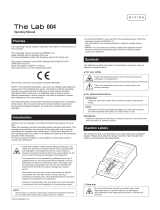
Table of Contents
6
5.4 Lockout setup............................................................................................................................................ 73
Operator lockout............................................................................................................................... 74
Quality control (QC) settings ....................................................................................................... 77
Quality control (QC) lockout ........................................................................................................ 79
Instrument quality control (IQC) lockout................................................................................. 80
QC result format ............................................................................................................................... 81
Custom Range Troponin T............................................................................................................ 82
Reset test parameters..................................................................................................................... 84
Cleaning lockout............................................................................................................................... 85
STAT test configuration ................................................................................................................. 86
5.5 Optional Screens setup .......................................................................................................................... 88
6 Performing a Test 91
Sample material ................................................................................................................................ 92
6.1 Preparing to test ....................................................................................................................................... 93
Code chip ............................................................................................................................................ 93
Inserting the code chip ................................................................................................................. 94
Test steps (overview) ...................................................................................................................... 95
Powering on the meter................................................................................................................... 96
Logging in ........................................................................................................................................... 97
6.2 Performing a test................................................................................................................................... 100
Inserting a test strip .................................................................................................................... 104
Displaying, confirming or adding comments to results.................................................. 109
STAT tests ........................................................................................................................................ 112
7 Control Testing and Quality Control 113
7.1 Preparing to run a quality control test .......................................................................................... 113
7.2 Performing a quality control test..................................................................................................... 115
Quality control (QC) ..................................................................................................................... 115
Instrument quality control (IQC).............................................................................................. 121
8 Review Results 125
Reviewing test results.................................................................................................................. 125
Patient history................................................................................................................................. 127
All results.......................................................................................................................................... 128
Quality control (QC) results....................................................................................................... 129
Instrument quality control (IQC) results ............................................................................... 130
Maintenance history .................................................................................................................... 131
9 Extended Functionalities 132
Data handling ................................................................................................................................. 132
Computer (Setup option)............................................................................................................ 133
Operator lists................................................................................................................................... 134
Patient lists....................................................................................................................................... 135
Barcode scanner............................................................................................................................ 136
Stored test results and comments .......................................................................................... 136
10 Cleaning and Disinfecting the Meter 139
Recommended cleaning/disinfecting solutions ................................................................ 140
Cleaning/disinfecting the exterior (meter housing)......................................................... 140
Cleaning after contamination due to mispipetting........................................................... 141
Cleaning the test strip guide cover......................................................................................... 142
Cleaning the visible area of the test strip guide................................................................ 143























